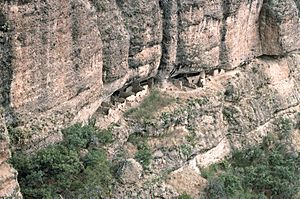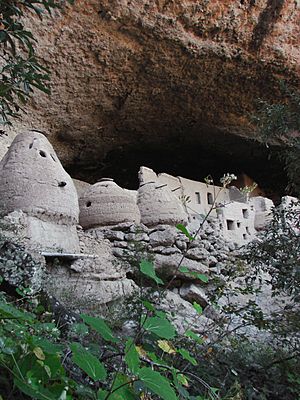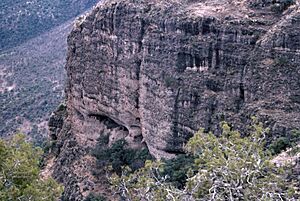Huápoca facts for kids
Quick facts for kids Paquimé - Mogollón Culture, Archaeological Site Oasisamerica |
||
| Name: | Huápoca Complex | |
| Type: | Archaeology | |
| Location: | Ciudad Madera, Chihuahua |
|
| Region: | Mesoamerica, Oasisamerica, (México) | |
| Coordinates | 29°11′21″N 108°20′35″W / 29.18917°N 108.34306°W | |
| Culture: | Mogollon - Paquimé | |
| Language: | ||
| Chronology: | ||
| Period: | ||
| INAH Web Page | Non existent | |
Huápoca is an ancient archaeological site located about 36 kilometers west of Ciudad Madera. It's found in the beautiful Huápoca Canyon, in the northwest part of the Mexican state of Chihuahua. This area is known for its amazing cliff dwellings.
When people visit the Huápoca region, they often explore the Rio Papigochi. They also check out cool spots like the Aguila and Serpiente caves, the Huápoca Spa, and the Huápoca bridge. These places give access to the ancient archaeological sites hidden in the cliffs.
In the Madera area, there are around 150 archaeological sites. Many of these are built into the cliffs. Sadly, many of these homes are damaged because they haven't been looked after. Some floors are broken, and walls have graffiti, even over ancient drawings.
Contents
Exploring the Huápoca Region
In 1898, a Norwegian explorer named Darl Lumbholtz was one of the first to tell the world about the caves in the Madera region. He found several sites, including one called Cueva del Garabato, which is now known as Cuarenta Casas.
After him, many other experts briefly explored the area. They mostly focused on the places near Cuarenta Casas. While they published their findings, we still don't know everything about these caves. Much more exploration and study are needed.
Some of the people who explored the region include:
- H.A. Carey in 1931
- E.B. Sayles in 1936
- A.V. Kidder in 1939
- R.H. Lister in 1946 and 1958
- Eduardo Contreras in 1959
- Arturo Guevara in 1986
- David Pearson, Fernando Sánchez M., and D. Phillips in 1990
The Madera Zone Caves
Madera was once a place where wood was cut from nearby forests. Today, its biggest attractions are the ancient caves in the area. These caves were once homes and shelters for people of the Paquimé culture. They built their houses right inside the caves!
There are several important Paquimé culture archaeological sites in the Madera area. Here are some of the most well-known caves:
Cueva Grande
This cave is located 66 kilometers west of Madera, reached by a dirt road. Cueva Grande is hidden within tricky terrain and behind tree branches. A waterfall from the top of the cave hides its entrance, flowing into a stream.
Inside, you can see two two-story houses that are 800 years old. They are great examples of how the native people built their homes. There's also a round area behind the houses that was used to store grain.
La Ranchería
La Cueva La Ranchería is a large group of homes, even bigger than Cuarenta Casas. It measures 50 meters long and 20 meters wide. Most of the rooms have two levels and are quite spacious. You can also find damaged granaries here, made from adobe and straw, where corn was stored.
Cueva del Puente
This cave is located 45 kilometers north of Madera.
Cuarenta Casas
Also known as Cuevas El Garabato or Cueva de Las Ventanas, Cuarenta Casas was built between 1060 and 1205 CE. It was a residential complex for the people of the Paquimé culture.
This complex, found in the Garabato Creek, has many interesting buildings. The large cave is protected by a small waterfall.
Cueva de la Momia
Inside this cave, explorers found the mummified body of an adult male. He was surrounded by offerings like pottery, stone tools, and corn cobs. This mummy is now kept at the Capitan Leal Museum in Ciudad Madera. It is in excellent condition.
It's believed that this cave, located near the Barranca Arroyo del Venado, might have had more mummies. However, some were sadly destroyed by careless visitors. The cave has two levels, and the second level has more than ten rooms that are still in great shape.
Cueva de las Jarillas
Cueva de las Jarillas is one of the biggest housing caves in the Madera region of Chihuahua. It has over 20 rooms and a special storage area called a Cuexcomate.
New Discoveries in the Canyons
In one of the canyons next to the Rio Papigochi, southwest of Madera, there's a complex of sites. Ancient communities lived here, building homes in caves and rock shelters. These sites are so well hidden that they are still almost untouched today.
You can't easily see any of these caves from the outside. The only way to know they are there is to be inside them!
Cueva de los Fierros
This cave is located halfway up the canyon slope, on an almost vertical wall. It's about 30 meters wide and has at least 10 adobe rooms, some with two floors. The whole structure sits on a foundation that acts like a terrace. The windows are shaped like a "T," which is a common style for the Paquimé culture.
Most of the rooms are partly damaged. However, the original wooden ceilings are still there. Inside, people found stone tools like scrapers, knives, and grinding stones. They also found pieces of pottery and many corn cobs, showing that corn was an important food source.
Cueva de la Puerta
This cave is just a few hundred meters from Cueva de los Fierros, also in the middle of the canyon wall. It's about 25 meters wide and has traces of about 12 rooms. Sadly, some floors and walls have been damaged by vandals or treasure hunters.
You can still see how these ancient houses were built. People used braided rods and branches from local trees, like juniper and ash, to create the structure. Then, they shaped adobe walls over these braids. The braids are still well preserved, and you can even see the fibers used to tie them. There are two types of fasteners: one made from "palmilla" fiber (a type of agave plant) and another from a tree branch called "sawarique." In one room, you can see the original adobe floor, which is so smooth it looks like cement. The roofs and walls of the rooms are black, probably from hundreds of years of smoke from fires.
On the opposite side of the canyon, there's a smaller cave with only three rooms, but they are very well preserved. About half a kilometer above, there's a tiny cave with a single, small house in excellent condition. It has a great view of the canyon, so it was probably used as a lookout point.
The People of the Paquimé Culture
Long ago, groups of hunter-gatherers came to this region from the north. They were likely from the Mogollon, Anasazi, or Hohokam cultures. They followed the Sierra Madre Occidental mountains, using plants and hunting small animals like turkeys. Over time, they settled near rivers and developed the Paquimé culture, also known as "Casas Grandes." The first people of this culture were collectors who were learning to settle down.
Evidence of the Mogollon has been found here, including simple pottery pieces. There are also some rarer, fancier items typical of the Paquimé culture. The people who built these sites were likely villagers. They used the environment wisely and also grew corn, squash, and beans. This helped them create a strong community.
The Casas Grandes culture is part of the larger Mogollon culture. Along with the Anasazi and Hohokam, these cultures make up the Oasisamerica area. This northern cultural region is called "Gran Chichimeca" in Mexico and the American Southwest in the United States.
Sites of this culture are found in the state of Chihuahua. Paquimé was the main city and trading center of the region. The earliest settlements of this culture date back to 1000 BCE. It was at its peak between 1261 and 1300 CE, and it disappeared around 1450 CE.
The challenging environment of this area shaped the people who lived here. They changed from nomadic hunter-gatherers to settled farmers who grew crops and raised animals. Their sites can be found from the Pacific Ocean coast all the way to the Sierra Madre Occidental, in many different environments.
The Huápoca Archaeological Site
The Huápoca site is a group of archaeological areas located near the Huapoca hot springs. The buildings here were made using adobe and reinforced with fibers.
These caves are considered some of the most impressive cliff dwellings. The structures that remain are still complete.
The Huápoca caves include the "Serpiente" and "Nido de Aguila" caves. These are truly amazing structures built right into the cliffs.
Both caves offer incredible views of the Huápoca Canyon. The remains at the site show building styles that are similar to other ancient sites in the region.
Cueva Grande
This is a very large and deep cave located 3 kilometers west of the Huapoca river and spa. It's a complex with two floors. A beautiful cascade falls right at the entrance of the cave.
- 29°11′20.5″N 108°20′35.4″W / 29.189028°N 108.343167°W
Cueva de la Serpiente
This cave has buildings that are in perfect condition. It's a group of homes with about 15 rooms, featuring the special "T"-shaped doors. The cave has two entrances and a path through a rocky area, which you can reach using a ladder.
- 29°12′49.9″N 108°19′59.2″W / 29.213861°N 108.333111°W
Nido del Águila
This cave, whose name means "Eagle's Nest," has several small houses built on a rock edge. They are located about two-thirds of the way up an almost vertical cliff. It's a smaller cave with two main buildings. One has at least three rooms right on the edge of the cliff. The other is a two-story room in the middle of the cave's open area.
- 29°12′27.5″N 108°19′55.3″W / 29.207639°N 108.332028°W
See also
 In Spanish: Huápoca para niños
In Spanish: Huápoca para niños






